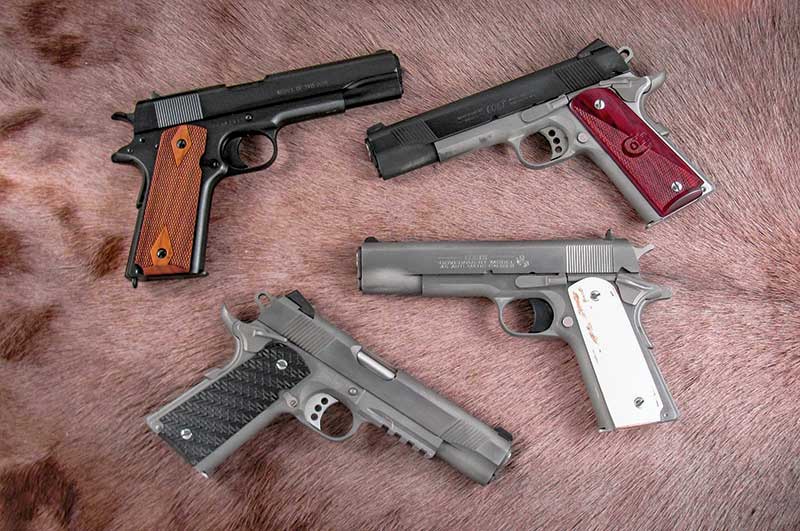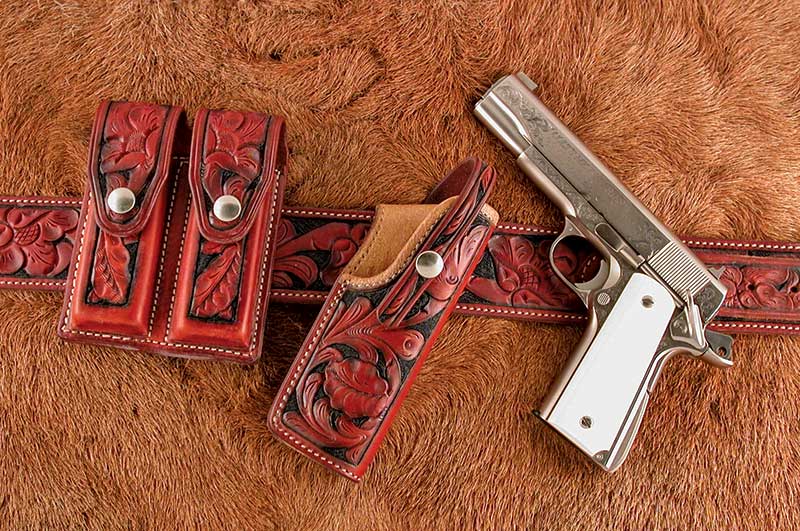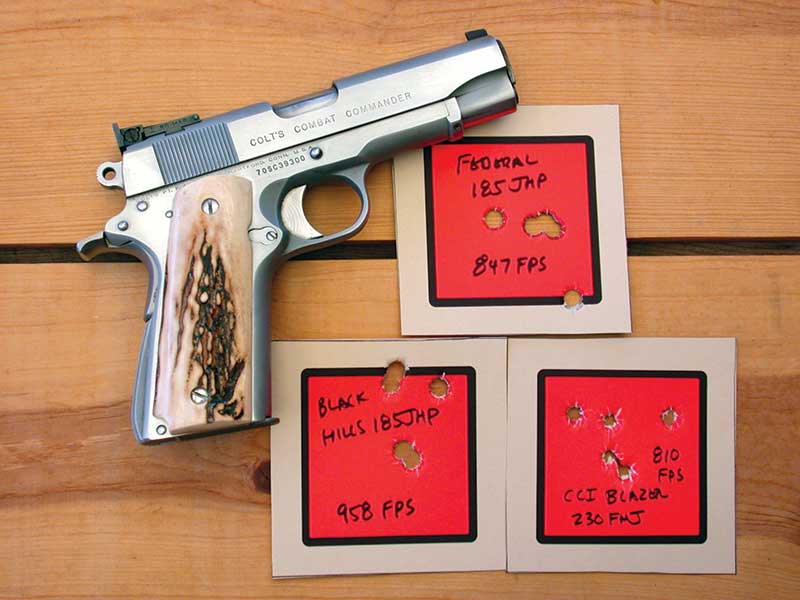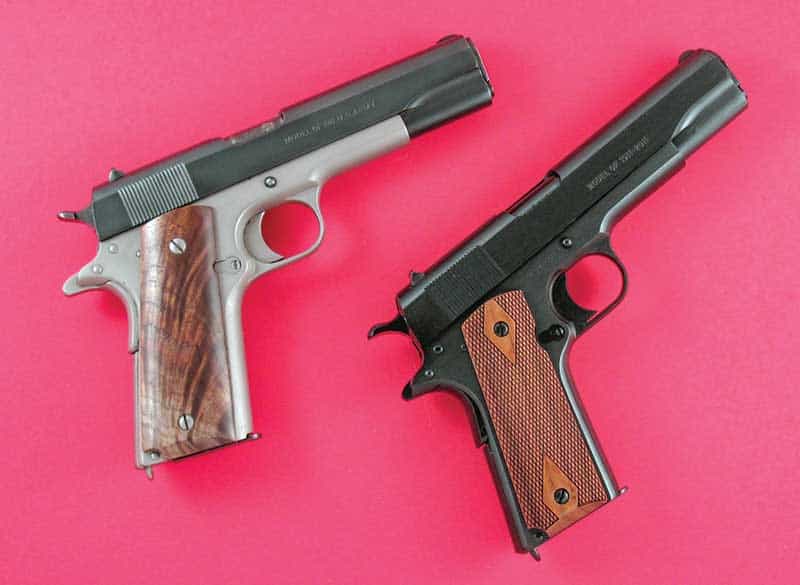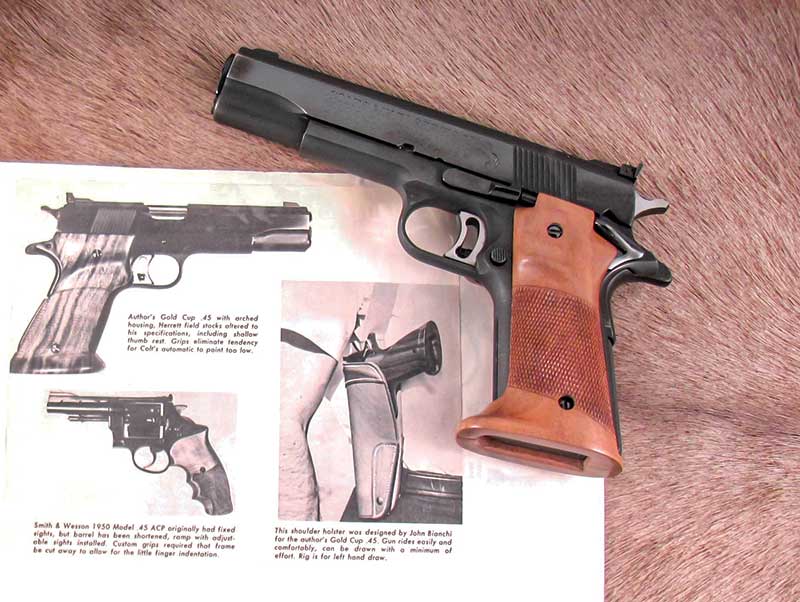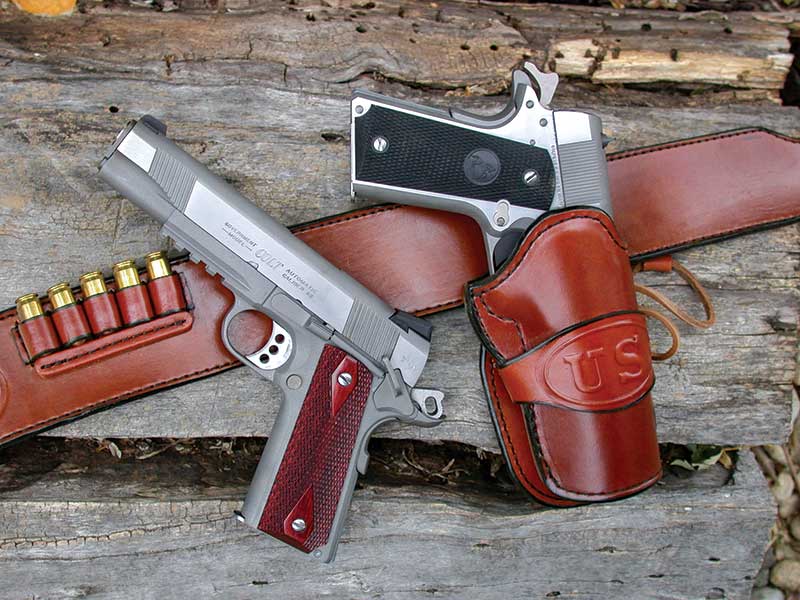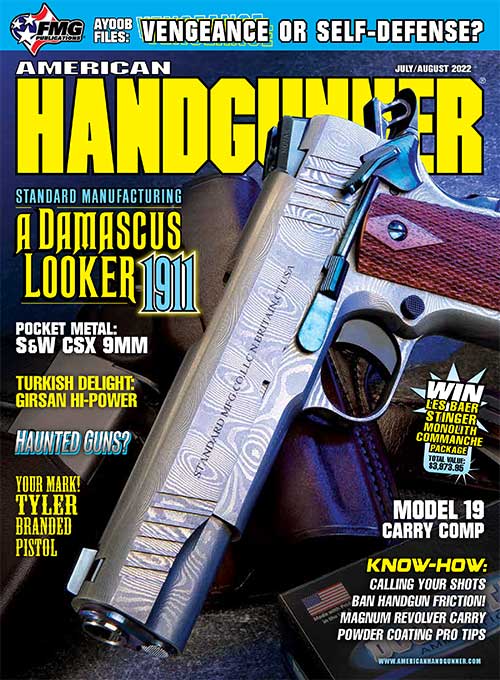The Sixgunner: Playin’ Favorites: The 1911 .45 ACP
During the mid-’50s, I also added to my collection both a 1911 Government Model and an S&W 1917, both relics of WWI and both chambered in .45 ACP. In those years, I often read how difficult the 1911 Government Model was to shoot. A shooter’s handgun choice is highly subjective and the Colt Single Action always has been and probably always will be my favorite, followed closely by an S&W such as the 4″ 1950 Target .44 Special. Right behind these two categories comes the 1911. With that in mind, I’d like to discuss my all-time favorite 1911s.
After the first World War, Americans began to discover the 1911. One of the first groups to adopt it, unofficially, were members of the Texas Rangers. I well remember seeing pictures more than 50 years ago of Rangers like Clint Peoples and Bob Crowder armed with a pair of fully engraved, ivory-stocked .45 Colt 1911s carried in floral carved holsters.
1911 Evolutions
The original 1911, just as my 1914 Commercial version, had tiny sights (at least for my eyes), a hammer that would quite often bite the area of the back of the hand between the thumb and forefinger and a flat mainspring housing. In 1923, the 1911 became the 1911A1 with two minor changes. One of the complaints of the 1911 was that it tended to shoot low. The flat mainspring housing was given an arch that moved the hand back slightly to bring the pistol up naturally. To compensate for this, the long trigger was shortened. Over the years, better sights arrived and the tang on the grip safety was lengthened to help alleviate hammer bite. Today this problem is mainly solved by a beavertail grip safety with a rounded spur hammer. One other change often seen is an extended thumb safety. All of the changes are minor and do nothing to affect the basic design of the .45. It is interesting to see the return of the flat mainspring housing. Sometimes progress corrects itself.
Commander
The U.S. Military used the 1911 through two world wars, and then in 1947, the Army began looking at the possibility of adopting a smaller, lighter .45 ACP pistol. Colt engineers came up with an alloy framed .45 weighing one-third less than the 1911 and having a barrel length of 41/4″compared to the original 5″ length of the 1911. The Army never did adopt such a pistol; however, in late 1949, Colt offered a commercial version of what is now known as the Commander. With its lighter weight of 26 oz., the Commander is much easier to carry all day than the 39-oz. all-steel version. However, the trade-off is its more significant felt recoil, so in 1970 an all-steel version was offered as the Combat Commander.
Two Days’ Pay
My experience with the 1911 began with a Remington-Rand surplus .45 purchased in the mid-1950s for two days’ pay when I was making 90 cents an hour. That old Remington loaded with war surplus hardball traveled with the family as we relocated from Ohio to Idaho. Sadly, something else beckoned, and I let it get away. However, I replaced it with my first Lightweight Commander .45 ACP. I fitted it with adjustable sights, sent it off to Ed Brown for one of the first Beavertail grip safeties, had my local ’smith polish the feed ramp and added full checkered grip panels by Herrett’s.
Early Customs
A few decades back, I was granted the privilege of testing some of the custom semi-automatics by Jimmy Clark. Jimmy was one of the early pioneers in tuning, tightening, polishing, accurizing and perfecting the 1911. One of those guns he sent to me was a Colt Combat Commander he had made up for a customer. From a Ransom Rest, this Colt .45 was right at 1″ at 50 yards, yet the customer refused it. I didn’t. I told Jimmy there was no way he was going to get it back, and he was such a gentleman he sold it to me for cost and said I could make payments. You can bet it is one of my favored Colt .45s.
Estate Find
Several decades back, a fellow at church came up to me and asked me if I would be interested in buying a Colt .45 from an estate sale he was settling. He said the price was $100, and I immediately said I’ll take it. He asked if I wanted to know anything about it, and I said, “No, for $100, I’ll take anything that is a Colt .45, be it sixgun or semi-automatic.” It turned out to be a Commercial Model from 1914. The grip frame had some pitting from someone’s sweaty hands, so I had the entire gun refinished with a blued slide and satin nickel frame. It is now well past the century mark, and it still shoots accurately and right to the point of aim. As old as it is, I don’t push it. However, with hardball or hardball-nosed cast bullets, it works just fine.
Series 70s
My early Series 70 was sent to Ed DeLorge to be engraved, satin nickeled and fitted with ivory grip panels. It is the perfect Texas Bar-B-Q Government Model, especially when paired with a fully carved El Paso Saddlery belt, holster and twin magazine pouch. It is a beautiful gun and I do shoot it. However, it looks so nice it gave me an excuse to pick up a plain Jane Series 70 for everyday use. I did have to fancy it up a little bit and it now wears ivory grip panels also.
As a young shooter, I learned a lot from a fellow named Kent Bellah. One of his axioms was a pair and a spare; if you have a gun you really like, you need to pick up a second one and then a third one just in case. My “spare” is a Series 70 also but in the Gold Cup configuration, complete with adjustable sights.
Gold Cup
I acquired Gold Cup fever from a fellow I later got to know, John Lachuk. In the early 1960s, he had a picture of a Gold Cup with very special grips — Combat Camp Perry grips by Herrett’s. They start as standard target grips and then the excess and unneeded wood like the thumb rest is removed. The result is a slightly larger pair of stocks, such as the custom Lew Sandersons preferred by Jeff Cooper. It took longer to get the stocks than to get the Gold Cup. However, my Gold Cup now wears Herrett’s Combat Camp Perry stocks.
Modern Production
I’ve only had them for a couple of years, but I will still predict four will become favorites before they go to the grandsons. Rate them “4F” — Fearsome Foursome of Future Favorites!
Virtually everyone producing 1911s came out with a 100th Anniversary Model .45 in 2011. Most of the Colt 1911s I experienced in my early shooting years were war surplus with a Parkerized finish — the original 1911s had a nicely polished finish. The Colt 100th Anniversary Model is polished and finished in a deep blue-black Colt called black oxide. Grip panels are double diamond, nicely checkered, walnut with a somewhat light tan finish and some grain pattern — beautiful and too nice to replace. As expected, it shoots exceptionally. Controls are also 100-year-old technology with no extension on the thumb safety or slide stop, and of course, no beavertail grip safety. The mainspring housing is flat and smooth just as it was on the original and is matched up with a long trigger. A great step back into history.
The Colt Combat Elite .45, which has all the features one could want in a carry/self-defense pistol, is also quite pleasing to look at as it is finished much like my 1914 Colt. The stainless-steel frame is matched up with a blue steel slide and the best-looking factory grips I’ve ever seen on a Colt 1911. They are fashioned of Rosewood with a diagonal line separating checkering to the right of this line from a smooth finish to the left. In the center, we find COLT nicely carved into each grip panel. Like the 100th Anniversary Model, I see no reason to swap grips on this 1911.
Two other Colt .45s are both stainless steel. The Government Model is a plain Jane with standard sights and controls and is an upgraded version of the classic blue 1911 with a finish made for rugged duty.
The second stainless Government Model is known as the Rail Model. This one has all kinds of extras in addition to the same brushed stainless-steel finish as well as the flat mainspring housing and long trigger and, of course, the same interior features and .45 ACP chambering. This pistol is designed for serious self-defense. Sights are fixed combat style of the three white dot variety with both being set in dovetails. The rear sight is melted, so there are no sharp edges to catch on clothing. The slide has deep diagonal serrations both front and rear for easy cocking.
The thumb safety is ambidextrous; the hammer is Commander style, the grip safety is the beavertail style hollowed out at the top to allow it to ride high and not interfere with the hammer. Grips are double diamond checkered exotic wood, which appears to be rosewood. An extra added feature gives this pistol its name as a machined-in rail is found in front of the trigger guard to accept a flashlight. This is, without a doubt, one of the best shooting Colt 1911s I have ever experienced.

